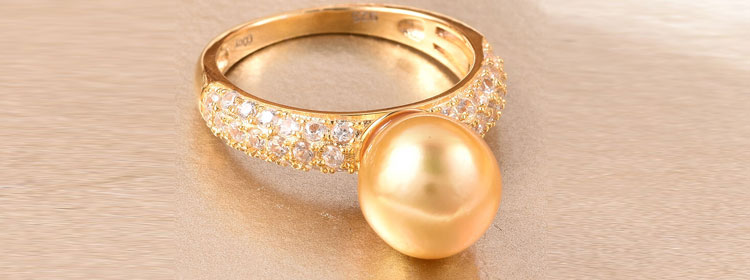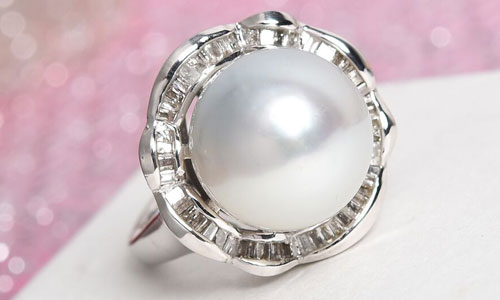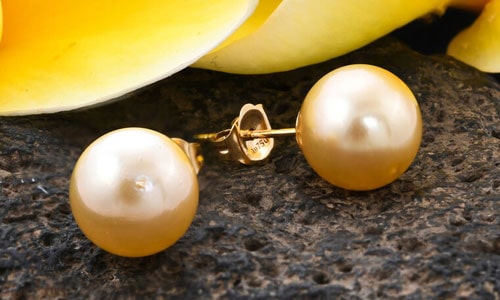
South Sea Pearls
Watch Video
Origin and Supply of South Sea Pearls
Facts about South Sea Pearls
- It ranks 2.5 to 4.0 on the Mohs scale of hardness
- South Sea pearls are not associated with any zodiac sign and don’t represent any star sign
- Pearls are regarded as the symbol of virtue, chastity, serenity, and purity in the Christian tradition
- Romans called pearls the tears of Venus, goddess of love, beauty, and desire.
- These pearls are the traditional gift for the 30th wedding anniversary

Properties of South Sea Pearls
Colour
The base and body colour of South Sea cultured pearls will appear close to pure white, buttery cream, or sparkling silver. These base colours can be influenced by hues of honey, tropical orange, and refreshing blue tones. Most of the South Sea pearls range between white and gold colours. These base colours are also influenced by secondary colours in some events; these secondary colours are known as the overtone. These cultured pearls can display overtones varying from rosy pinks, pastel greens, and baby blues.
Shape
Most coveted South Sea pearls come in round shape for which they are well known, but they may also come in baroque shapes that can be irregular or oblong in shapes, making them extremely beautiful and unique.
Lustre
South Sea pearls display an excellent lustre. These pearls reflect bright and sharp contrasting light. These pearls have a clean or sometimes lightly spotted surface, allowing light to beautifully reflect through it.
Size
South Sea pearls are largest in size as per other pearls. They grow typically to sizes between 9mm and 20mm. Their average size is about 12mm.

What to remember while buying South Sea Pearls?
- South Sea Pearls appear much more satin-y and softer than Freshwater pearls or Japanese Pearls.
- Know where your pearl came from. Mostly, the south sea pearls are formed in Australia or Philippines.
- South sea pearls are coveted for their gorgeous natural colours. Remember that all the colours on south sea pearls are natural. Sometimes you will see overtones of rose gold or yellow gold.
- The smallest size you’ll find it in is 8-9mm and the maximum size you can naturally find them in is 16mm.
- They came quite late to the jewellery world, starting to be traded in 1950s.
- A naturally cultivated south sea pearl takes 2 years to harvest.
- No added processing takes place to get the lustre and colour to the pearls, they’re very natural.
New Arrivals
Frequently Asked Questions about South Sea Pearls
South Sea pearls are cultured from Pinctada maxima, thus the first and foremost requirement for raising healthy oysters and culturing of South Sea pearls is warm waters. It is mandatory that the water is clean and unpolluted as polluted waters negatively impact the quality of pearls produced. White or golden pearls will develop depending on the oyster. You can easily tell what colour of pearl will grow by checking the lip of Pinctada maxima. White-lipped shells produce white pearls, while gold-lipped shells produce golden pearls. Healthy and suitable oysters are identified based on their size and the quality of the nacre they produce. Some of these oysters are sacrificed to provide the seed for new pearls. When the oysters are harvested, shells are shaped into round beads. These beads are then inserted into the broodstock, that is afterwards placed in cages for safety and left to grow in the sea. It takes 2 to 4 years for these beautiful pearls to grow. Meanwhile, workers keep a check on the health of the mollusks, keeping their mouth and opening clean and making sure that natural predators are not damaging the farming broodstock. Submerging the oysters between 30- 40 meters deep is considered, and it accelerates its growth. When the oysters are ready for harvest, the best oysters are reseeded to grow and develop a new generation of pearls. As the oyster has fully grown during this time, the future stock is likely to be larger. In the same way, multiple generations of pearls can be grown. Remaining stock is harvested, and pearls are collected from them.
After harvesting, shells are used to seed a new generation of oysters. They are also used as Mother of Pearl n jewellery and other decorative items.
These pearls are all-natural and organic and don't undergo any artificial treatment or enhancement.
Being the rarest and the largest most cultivated pearls in the world, these pearls are expensive. They can be cultured in particular regions requiring a particular environment and conditions, making them expensive.
The overall smoothness and clarity and lustre determines the price of these pearls. Blemishes also help in determining the value; more it is blemish-free more is its value.
Like other pearls, this cultured pearl is also delicate. The nacre of the pearl can wear or chip away if you don’t take extreme care of the pearls. You must store your pearls in a different box with a soft lining so that no other metal or jewellery can rub against them. It should be taken care of that no makeup, hairspray or harsh soaps or chemicals comes in contact with your pearl.
This pearl is one of the three birthstones for the month of June, along with moonstone and alexandrite.

